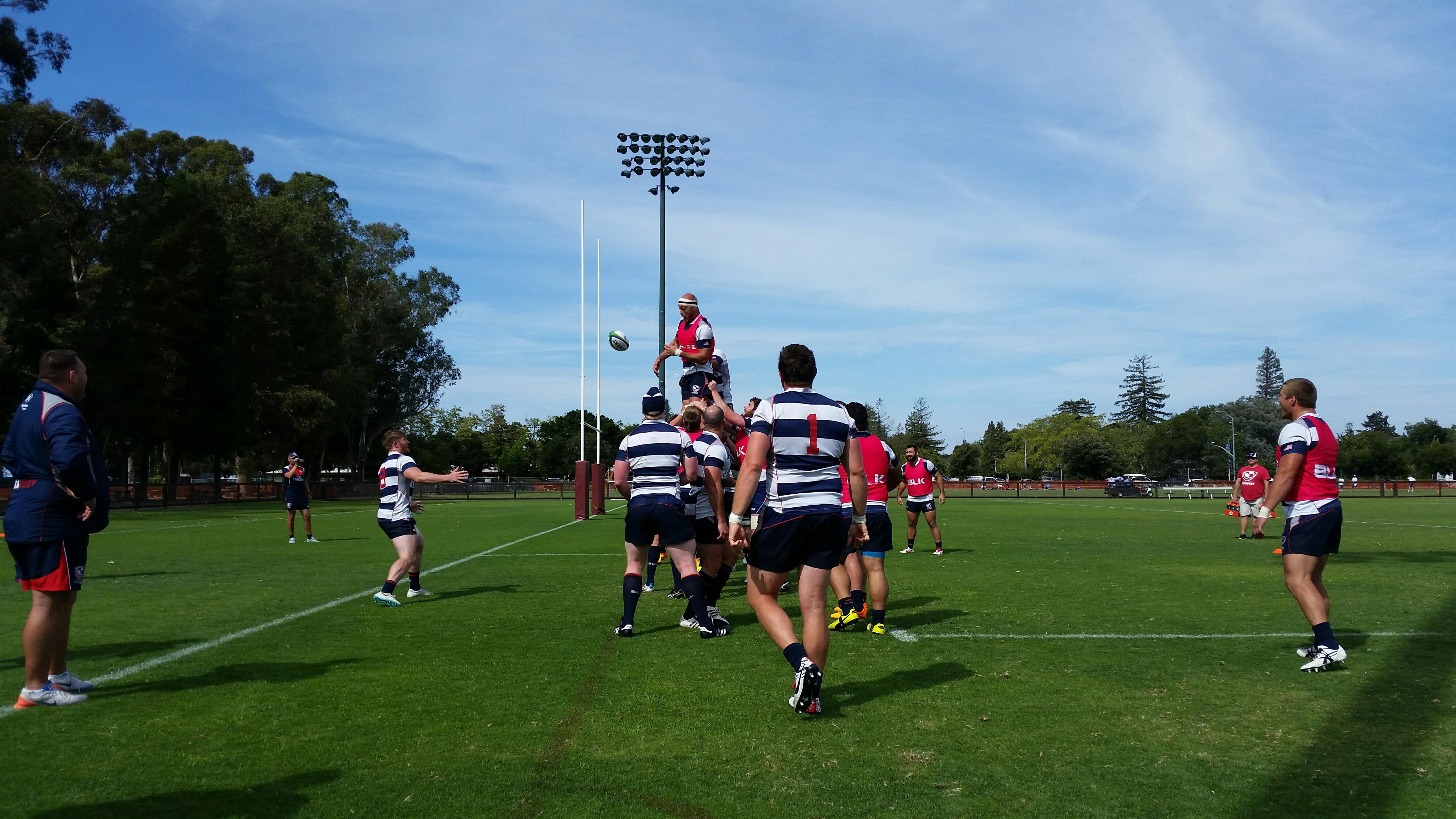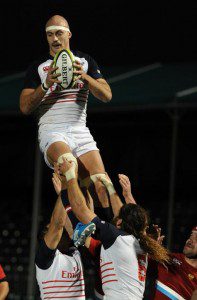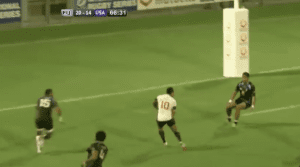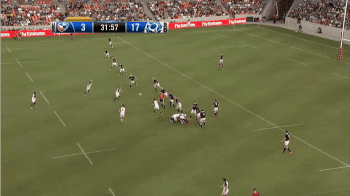

PHILADELPHIA, PA – As the *Pacific Nations Cup (PNC) approaches this week, and the World Cup looming beyond that, it is no secret that the lineout is an important chance for the Eagles to attack. The importance of the lineout is heightened by their struggles at scrum time. Beyond that, the Eagles have not yet had a fly half fully directing the attack. At many points, in fact, the Eagles seem to be running patterns which are specifically designed to reduce the demands – both physical and tactical – on the fly half.

With that in mind, I went back and looked at seven of the Eagles relatively recent matches: Uruguay (2), Scotland, Japan, Romania, Tonga, and Fiji, skipping the match against the All Blacks because of its one-sided nature.
There were 106 scrums during those 7 games (compared to 176 lineouts) and the Eagles fed only 38 of those scrums.
As those numbers indicate, there are fewer scrums and the Eagles are less likely to get good ball from a scrum, so the lineout is clearly the more important attacking opportunity for the Eagles.
The Eagles have two main lineout packages they use pretty equally: the 7-man and 5-man. As shown below, the success rate was higher for the 5-man than the 7-man. The US is also more likely to use off-the-top ball than not.
| won/chances | success rate | |
| All US lineouts | 68/87 | 78% |
| All US opponents’ lineouts | 66/89 | 74% |
| US 7-man | 26/35 | 74% |
| US 5-man | 32/39 | 91% |
| US to the front | 21/23 | 91% |
| US to the middle | 29/39 | 74% |
| US to the tail | 15/22 | 68% |
In the first game last spring against Uruguay, the Eagles had a disappointing performance. Not coincidentally, there were only 5 US lineouts that game. Against Fiji in the fall, things went quite differently and the US won 18 of 19 lineouts. Despite being underdogs, they were in that game until the end and, perhaps, should have won.

Scott LaValla is the key figure in the lineout going well. Against Romania, the lineout did not function well (6 from 12 chances) and that may be the result of LaValla not playing in that match/ calling the lineouts.
Phil Thiel made most of these throws, with Tom Coolican a capable understudy.
In terms of success once the Eagles win ball, two questions present themselves:
-What have they done?
-What should they do?
The goal for the recent Eagles is often to have a crash ball in the middle, generate quick ball, and attack in earnest in phase 2. That works only when the runner generates momentum and players arrive at the ruck quickly and operate effectively. Looking more closely, though, there is an even clearer pattern the Eagles like to run. The pattern works best from the 5-man lineout, but they’ve also used the same basic structure from the 7-man.
The throw goes to the middle or tail of the lineout and the ball is delivered to the scrum half off the top. Then there are two pretty straight-forward passes: 9-to-10 and 10-to-12. The inside center crashes while the fly half continues running away from the side of the field where the lineout occurred. Phase 1 ends with the inside center being tackled. The players who commit to the ruck seems to be designed (last man in the lineout, weak side wing, and one of the forwards not in the lineout). Phase 2 starts with another 9-to-10 pass. The fly half has several players to whom he can distribute: the outside center cutting back inside, the other forward not involved in the lineout, or the full back. There should also be one or two trailing forwards on his inside shoulder. The options are all relatively short passes.
Here are two examples of this move working. The 9 in both is Mike Petri and the 10 in both is Shalom Suniula. Against Tonga, Andrew Suniula is 12, Folau Niua is 15, and the winger is Tim Stanfill.
Against Fiji, it was a 7-man lineout, so the forwards had to hustle to support. Thretton Palamo is 12, Ronnie McLean is 15, and the winger is Takudzwa Ngwenya.
In the above examples, it seems clear that the 10 has an important decision to make in the second phase, but the passes are simple. Also, this is a decision that can be well-rehearsed and does not rely too much on improvisation. With this pattern, and others, Mike Tolkin seems to be constructing a sensible plan that runs the risk of being predictable.
The crash move is not successful every time. In another example from Fiji, only two players went to clear after the crash. They were not able to move the defender, and the Eagles were penalized for not releasing. It was a 5-man lineout that produced good ball from a decent attacking position. Yet, the Eagles got nothing from it. Those kinds of chances cannot be squandered if the Eagles are going to have a chance to win matches in the PNC or World Cup.
In order for the move to work, the crash needs to be effective. The same pattern was used against Japan, but it only went sideways. Seamus Kelly was the inside center. His crash was not nearly as effective as the examples above. Still, the ball was produced quickly for Phase 2. (Because the ball was thrown to the tail, it was Louis Stanfill rather than the prop at the end of the lineout who joined Danny Barrett and Tim Maupin in the ruck.) Samu Manoa was the forward who was the option for Shalom Suniula, so that should have attracted some attention from the defense. Chris Wyles was the full back. He is not surging forward when he receives the ball and drifts slightly to his right, cutting down on the space for Blaine Scully on the wing.
It is possible the Japanese defense was simply better than Tonga’s or Fiji’s. This seems to be a good reminder that simply having 3 professional players – Manoa, Wyles, and Scully – working together is not a guarantee of anything. The Eagles kept the ball, but the move was not incisive.
Here is the same pattern against Uruguay from a throw to Todd Clever at the tail. Andrew Suniula gets over the gainline with a strong run. Kelly and Louis Stanfill clear out and provide quick ball. Toby L’Estrange has Manoa and Wyles outside of him, with Clever looping around to join them. Instead, he throws a forward pass to the inside and the move is killed.
Though off-the-top-ball is more common, they can maul. The first example shows a penalty being earned after pressure is created by the maul.
However, good decision-making is required at the end of the maul. In this second example from last summer’s match against Japan, the maul ends with a knock on.
In contrast to that clear sense of a pattern with a purpose that results in pretty tries for wingers (like against Tonga and Fiji), here is a picture from the match against Scotland. The US conceded a penalty try. Then, Scully won the ball from the restart. At the start of Phase 2 below, it is clear the Eagles are slow to organize in attack.

This is a prime attacking opportunity, and the Eagles seem unsure of what to do with it. This highlights why lineouts are such a big deal for the US.
Hopefully, in the games this summer, the Eagles can build on what they are already doing well. For instance, in the examples above, neither the scrum half nor the fly half make a real decision about their first pass. Therefore, the defense is not fully tested until the second phase, and the Eagles run the risk of being predictable. There are way to make the first phase more dynamic.
In addition to Lavalla, Clever is a key man for the lineout. Considering the lineout, along with other aspects of play, the lineup for 4-8 that was used against Japan makes the most sense to me: Manoa, LaValla, Barrett, Clever, Cam Dolan.
The lineout shows that the Eagles can attack well when everyone is working together and knows his role. They have the time this summer to improve and increase the number of and types of situations in which all 15 are working together well.
Feel free to comment below, look for and “Like” our Facebook Rugby Wrap Up Page and follow us on Twitter@: RugbyWrapUp, Junoir Blaber, James Harrington, Jamie Wall, Nick Hall, DJ Eberle, Jake Frechette, Scheenagh Harrington, Jamie Loyd, Cody Kuxmann, Karen Ritter, Audrey Youn, Akweley Okine, Rocky Brown and Declan Yeats, respectively.
*ESPN3 will be covering all matches. Click here for the schedule.

